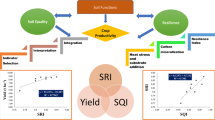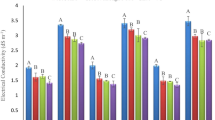Abstract
Failures in agricultural development in parts of West Africa may have been caused by the inability of the farmers to develop the abundant inland valleys for cultivation of such crops like rice, using appropriate water management systems. An inland valley in southeastern Nigeria was used to evaluate the influence of sawah and non-sawah water management using inorganic and organic soil amendments on the soil chemical properties and rice grain yield. Soil chemical properties tested were soil organic carbon, total nitrogen, pH, exchangeable K+, Ca2+ and Mg2+. Others were CEC, percent base saturation and exchangeable acidity while the grain yield of rice was also measured. The soils are loose, low in pH and poor in plant nutrient elements. In spite of that, the sawah-managed system was able to improve the pH of the soil by raising it slightly both in the first and second year of planting. Generally, essential plant nutrients such as exchangeable K+, Ca2+ and Mg2+, including fertility index like the CEC, were improved within sawah management within the period. Also, rice grain yield increased significantly (5.62 and 6.25 tons/ha in the first year and 5.32 and 6.53 tons/ha in the second year for non-sawah and sawah, respectively) with sawah system such that about 11 and 23% yield increases were obtained in sawah over the non-sawah in the two years, respectively. Although organic carbon can be used to explain the variation in total grain yield in the first year, it was the CEC that explained the total grain yield in the second year. The study revealed the superiority of sawah over non-sawah in the production of lowland rice in an inland valley in southeastern Nigeria.





Similar content being viewed by others
References
Agbim NN (1985) Potentials of cassava peels as a soil amendment. II. Field evaluation. J Environ Qual 14:411–415
Bray RH, Kurtz LT (1945) Determination of total, organic and available forms of phosphorus in soils. Soil Sci 59:39–45
Buri MM, Ishida F, Kubota D, Masunaga T, Wakatsuki T (2000) Sulfur and zinc levels as limiting factors to rice production in West Africa lowlands. Geoderma 94:23–42
Enwezor WO, Udo EJ, Sobulo RA (1981) Fertility status and productivity of the ‘acid sands’. In: ‘Acid Sands’ of southeastern Nigeria. Soil Science Society of Nigeria Special Publication, Monograph 1, pp 56–76
FAO (1988) Soil map of the world revised legend. World soil resources report 60, Rome, 119 pp
Fashola OO, Hayashi K, Wakatsuki T (2002) Effect of water management and polyolefin-coated urea on growth and nitrogen uptake of indica rice. J Plant Nutr 25:2173–2190
Ganawa ESM, Soom MAM, Musa MH, Shariff ARM, Wayayok A (2003) Spatial variability of total nitrogen and available phosphorus of large rice field in sawah sempadan Malaysia. Sci Asia 29:7–12
Gee GW, Bauder JW (1986) Particle-size analysis. In: Klute A (ed) Methods of soil analysis, Part 1, American Society of Agronomy 9, Madison, pp 91–100
Hirose S, Wakatsuki T (1997) Restoration of ecological environment and regeneration of rural areas in West Africa savannah (in Japanese). Association of Agriculture and Forestry Statistics, Tokyo, 600 pp
Hirose S, Wakatsuki T (2002) Restoration of inland valley ecosystems in West Africa. Norin Tokei Kyokai, Tokyo, 600 pp
Igwe CA, Akamigbo FOR, Mbagwu JSC (1995) Physical properties of soils of southeastern Nigeria and the role of some aggregating agents in their stability. Soil Sci 160:431–441
Mbagwu JSC (1985) Subsoil productivity of an Ultisol in Nigeria as affected by organic wastes and inorganic fertilizer amendments. Soil Sci 140:436–441
Mbagwu JSC (1989) The agricultural soils of Nigeria: properties and agronomic significance for increased productivity. Beitr Trop Landwirtsch Veterinärmed 27:395–409
Mbagwu JSC (1992) Improving the productivity of a degraded Ultisol in Nigeria using organic and inorganic amendments. Part I: Chemical properties and maize yield. Bioresour Technol 42:149–154
McLean EO (1982) Soil pH and lime requirement. In: Page AL, Miller RH, Keeney DR (eds) Methods of soil analysis, Part 2. America Society of Agronomy, Madison, pp 199–224
Nelson DW, Sommers LE (1982) Total carbon, organic carbon and organic matter. In: Page AL, Miller RH, Keeney DR (eds) Methods of soil analysis, Part 2. America Society of Agronomy, Madison, pp 539–579
Nnabude PC, Mbagwu JSC (2001) Physico-chemical properties and productivity of a Nigerian Typic Haplustult amended with fresh and burnt rice-mill wastes. Bioresour Technol 76:265–272
Ofori J, Hisatomi Y, Kamidouzono A, Masunaga T, Wakatsuki T (2005) Performance of rice cultivars in various sawah ecosystems developed in inland valleys, Ashanti region, Ghana. Soil Sci Plant Nutr 51:469–476
Rhoades JD (1982) Cation exchange capacity. In: Page AL, Miller RH, Keeney DR (eds) Methods of soil analysis, Part 2. America Society of Agronomy, Madison, pp 149–157
Thomas GW (1982) Exchangeable cations. In: Page AL (ed) Methods of soil analysis, Part 2. America Society of Agronomy, Madison, pp 159–165
Unamba-Oparah I (1985) The potassium status of the sandy soils of northern Imo State, Nigeria. Soil Sci 139:437–445
UNEP (1997) World Atlas of desertification, 2nd edn. Arnold, London
UNEP/ISRIC (1991) World map of the status of human-induced soil degradation. UNEP, Nairobi
USDA (1998) Keys to soil taxonomy, 6th edn. SMSS, Washington, DC, 306 pp
Wakatsuki T, Masunaga T (2005) Ecological engineering for sustainable food production of degraded watersheds in tropics of low pH soils: focus on West Africa. Soil Sci Plant Nutr 51:629–636
Wakatsuki T, Buri MM, Fashola OO (2005) Ecological engineering for sustainable rice production and the restoration of degraded watersheds in West Africa. In: Proceedings of rice research conference, IRRI, pp 336–366
Wakatsuki T, Otoo E, Olaniyan OG (2002) Restoration of degraded inland watersheds in West Africa: eco-technology approach. In: Proceeding of 17th WCSS, 14–21 August 2002, Thailand, 1202_1–1202_8
Witt C, Dobermann A, Buresh R, Abdulrachman S, Gines HC, Nagarajan R, Ramanathan S, Tan PS, Wang GH (2005) Site-specific nutrient management and the sustainability of phosphorus and potassium supply in irrigated rice soils of Asia. In: Proceedings of rice research conference, IRRI, pp 360–363
Author information
Authors and Affiliations
Corresponding author
Rights and permissions
About this article
Cite this article
Nwite, J.C., Igwe, C.A. & Wakatsuki, T. Evaluation of sawah rice management system in an inland valley in southeastern Nigeria. I: Soil chemical properties and rice yield. Paddy Water Environ 6, 299–307 (2008). https://doi.org/10.1007/s10333-008-0123-0
Received:
Accepted:
Published:
Issue Date:
DOI: https://doi.org/10.1007/s10333-008-0123-0




